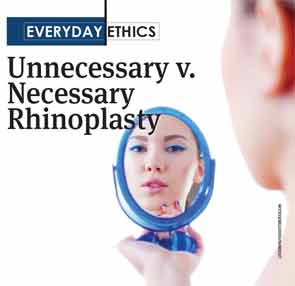Explore This Issue
May 2014
Scenario: A 17-year-old female patient presents for a consultation regarding what she calls a “big hump on my nose.” She is about to graduate from high school and will be attending college to study communications and public relations. She wishes to have a “new appearance” for her nose as she begins college.
Neither the patient nor her father, who possesses a similar nasal appearance, can relate any specific traumatic event involving her face or nose. The young woman does describe participating in athletic events, including gymnastics and swimming, but without any re-collection of nasal trauma. She also denies nasal obstruction at rest or during exercise and has no history of nasal allergies. Although the patient appears to have a good self-image, her father admits that the nasal abnormality has caused her to be shy about meeting other young people. She has been working through high school to save money for college and is hoping to do well enough to warrant a merit scholarship. Her father states that they are of modest financial means but that he will take on a second job if necessary to provide this surgery for her.
On physical examination, the patient appears to be healthy and makes eye contact with you some of the time. In general, her facial symmetry appears good, except for a large bony-
cartilaginous hump deformity that could be understood to detract from her facial appearance. The dental occlusion is Class I. Anterior rhinoscopy reveals only a very small deflection of the septum at the left inferior maxillary crest, which appears to have little or no functional significance. The turbinates are of normal size and appearance. Rigid rhinoscopy reveals no further intranasal abnormalities. Palpation of the hump deformity confirms its composition of both osseous and cartilaginous components. The skin over the dorsal hump deformity is void of any scars. The remainder of the head, face, and neck examination is normal.
You would like to help this young woman achieve a more pleasant facial appearance, and your clinical impression is that lowering the nasal dorsal hump deformity could also give her a more confident facial self-image. You are also aware that, based on clinical guidelines and experience with her family’s insurance coverage, she would not qualify for third-party payment; however, you know that you could submit information to the insurance company for pre-
authorization that would raise the “possibility” that her athletic endeavors since childhood could have resulted in a silent or unrecognized injury to the nose, in spite of the fact that you believe this deformity is likely hereditary. Additionally, you could emphasize the presence of the maxillary crest spur so that it rises to a level of nasal airway compromise. After all, if the goal of medicine is to help patients, then what would be wrong with helping your patient in this manner? She could then use her hard-earned savings for her college education.
Leave a Reply